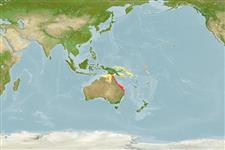>
Acanthuriformes (Surgeonfishes) >
Pomacanthidae (Angelfishes)
Etymology: Chaetodontoplus: Greek, chaite = hair + Greek, odous = teeth + Greek, plous, ous, oo = crossing (Ref. 45335).
Environment: milieu / climate zone / depth range / distribution range
Ökologie
seewasser riff-verbunden; standorttreu; tiefenbereich 10 - 50 m (Ref. 48391). Subtropical
Western Pacific: Queensland, Australia. Reported to range south to New South Wales and Lord Howe Island (Ref. 9710).
Size / Gewicht / Alter
Maturity: Lm ? range ? - ? cm
Max length : 25.0 cm TL Männchen/unbestimmt; (Ref. 2334)
Kurzbeschreibung
Morphologie | Morphometrie
Rückenflossenstacheln (insgesamt): 13; Rückenflossenweichstrahlen (insgesamt): 17-19; Afterflossenstacheln 3; Afterflossenweichstrahlen: 17 - 19. Trunk black; the forehead, snout, breast, and caudal fin yellow; side of the head mostly blue with yellow spots; a wide white bar just behind the head, running from the below the forehead to the base of the pectoral fin; dorsal and anal fins with narrow yellowish to bluish white margin.
Inhabits coastal reefs and open bottoms with rock , coral, sponge, or seawhip outcrops to depths greater than 3 5 m (Ref. 9710). Juveniles often among sponges under jetties; adults often in pairs, generally in deeper water (Ref. 9710). Feeds on sponges and tunicates. Solitary or forms pairs or small groups. Occasionally exported through the aquarium trade (Ref. 48391).
Life cycle and mating behavior
Geschlechtsreife | Fortpflanzung | Ablaichen | Eier | Fecundity | Larven
Randall, J.E., G.R. Allen and R.C. Steene, 1990. Fishes of the Great Barrier Reef and Coral Sea. University of Hawaii Press, Honolulu, Hawaii. 506 p. (Ref. 2334)
IUCN Rote Liste Status (Ref. 130435)
Bedrohung für Menschen
Harmless
Nutzung durch Menschen
Mehr Information
NamenSynonymeMetabolismusRäuberÖkotoxikologieFortpflanzungGeschlechtsreifeAblaichenSpawning aggregationFecundityEierEientwicklung
Alter/GrößeWachstumLänge-GewichtLänge-LängeLängenhäufigkeitenMorphometrieMorphologieLarvenLarven Pop.Dyn.RekrutierungDichteBRUVS
ReferenzenAquakulturAquakultur ProfilZuchtlinienGenetikElectrophoresesVererbbarkeitKrankheitenVerarbeitungNutrientsMass conversion
PartnerBilderStamps, Coins Misc.LauteCiguateraGeschwindigkeitSchwimmstilKiemenoberflächeOtolithsGehirngrößeSehfähigkeit
Tools
Zusatzinformationen
Download XML
Internet Quellen
Estimates based on models
Preferred temperature (Ref.
123201): 23.9 - 27.6, mean 26.1 °C (based on 78 cells).
Phylogenetic diversity index (Ref.
82804): PD
50 = 0.5000 [Uniqueness, from 0.5 = low to 2.0 = high].
Bayesian length-weight: a=0.03090 (0.01359 - 0.07026), b=2.89 (2.70 - 3.08), in cm total length, based on LWR estimates for this (Sub)family-body shape (Ref.
93245).
Trophic level (Ref.
69278): 3.0 ±0.00 se; based on food items.
Widerstandsfähigkeit (Ref.
120179): mittel, Verdopplung der Population dauert 1,4 - 4,4 Jahre. (Preliminary K or Fecundity.).
Fishing Vulnerability (Ref.
59153): Low vulnerability (15 of 100).
Nutrients (Ref.
124155): Calcium = 35.9 [16.1, 68.0] mg/100g; Iron = 0.559 [0.324, 0.970] mg/100g; Protein = 19 [18, 20] %; Omega3 = 0.161 [0.092, 0.274] g/100g; Selenium = 14 [7, 29] μg/100g; VitaminA = 47.1 [12.0, 179.4] μg/100g; Zinc = 0.898 [0.572, 1.360] mg/100g (wet weight);
